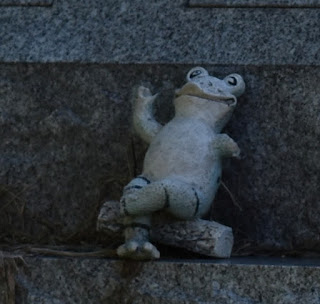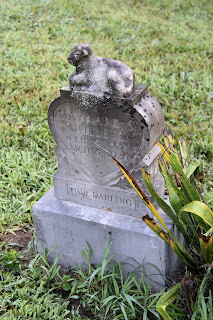The Leo Petroglyphs State Monument features a sandstone slab purported to portray 37 different images, many of them so eroded as to be unreadable. Even the more distinct images are enigmatic: is that a happy person wearing a weird head-dress or a monster with immense pincers? Whoever carved them has been dead for a thousand years or so and they didn't leave behind a translation, so we just stooped over them looking puzzled, then we clambered down the nature trail to look at caves and gorges and puzzled over why so much poison ivy was allowed to intrude on the path.
Later we climbed a hill to Pierce-Mather Cemetery, on land once owned by Professor William Williams Mather, a descendant of Richard Mather, the patriarch of the family that gave us Cotton Mather and Increase Mather. William Williams Mather came to Ohio in 1837 to serve as the state's chief geologist, assisted by Charles Whittlesey, a distant cousin of my mother's. Professor Mather taught geology at Ohio University but also briefly served as a geology professor at Marietta College, so I guess I can call him a colleague. He donated some lovely hilltop land for the cemetery where his wife was buried, and flanking her gravestone were the graves of their infant sons, Cotton and Increase Mather.
At least that's what the history books tell us. The gravestones themselves tell us precious little, too eroded and covered with lichens to be decipherable. We saw graves for Howes and Swingles and Pierces and many others but did not locate a single Mather. So history eluded us, but it gave us a good excuse to wander around gorges and hillsides on a lovely summer morning.
And it provided one last puzzle: I understand the lambs on infants' gravestones and the occasional attempt at imitating draperies, but what compels a person to put a small ceramic grinning frog on a gravestone? If you figure it out, please enlighten me.
 |
| Petroglyphs |
 |
| Into the gorge. |
 |
| My source tells me this is yellow crustose lichen, growing on a tombstone. |
 |
| The view from the Pierce Mather Cemetery. |
 |
| Um, what? |










No comments:
Post a Comment